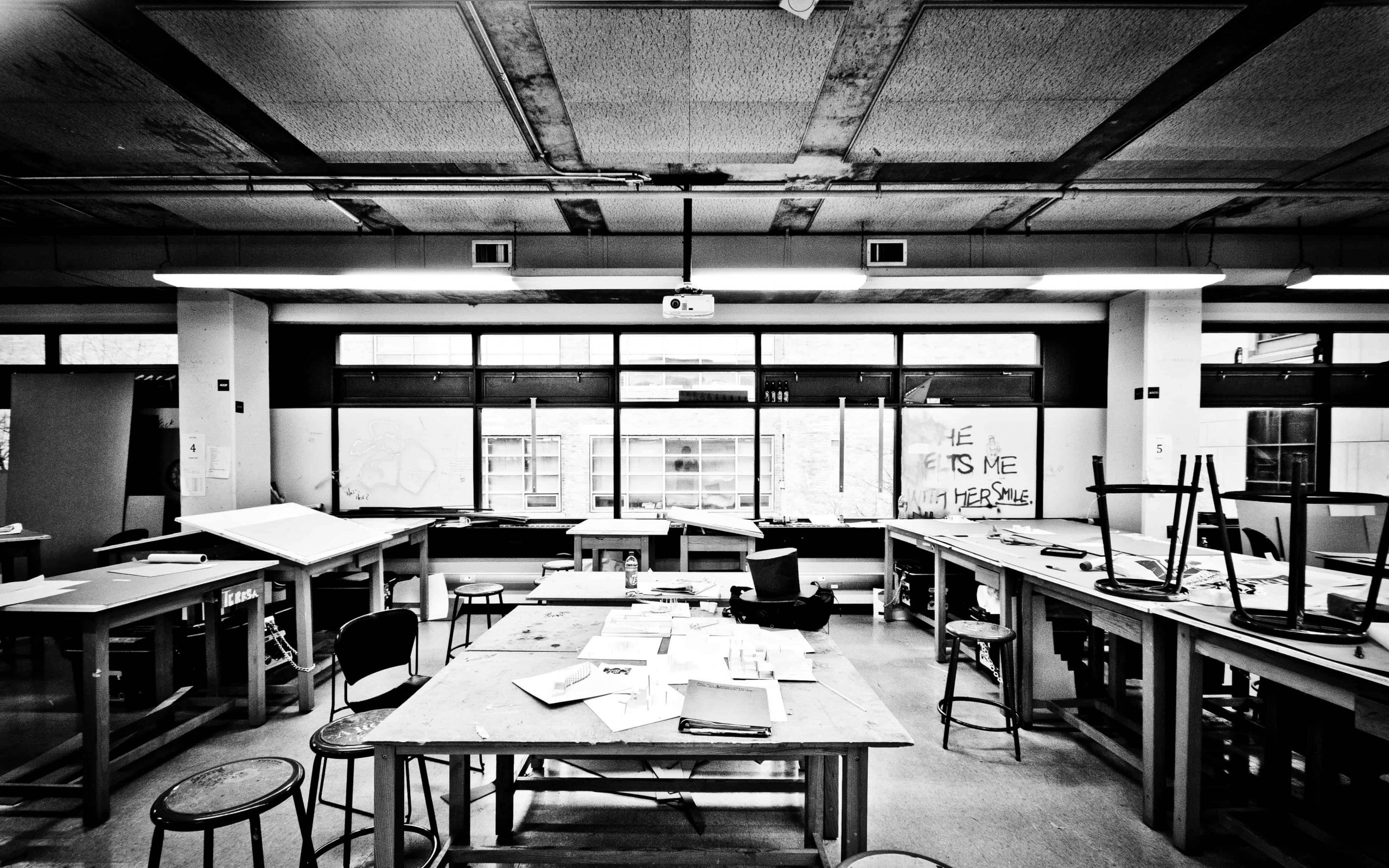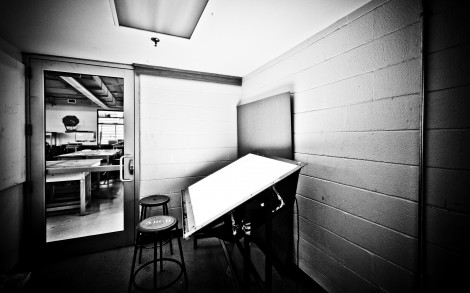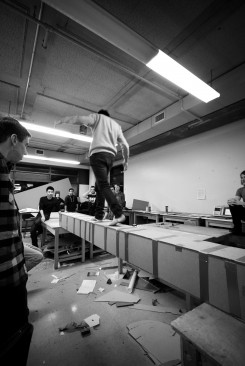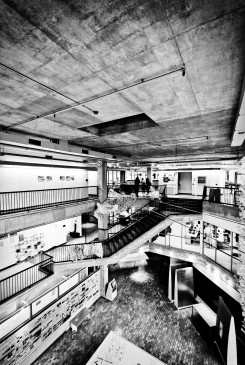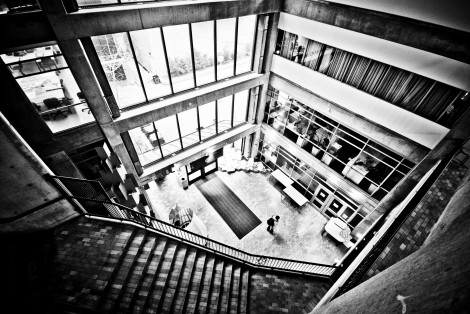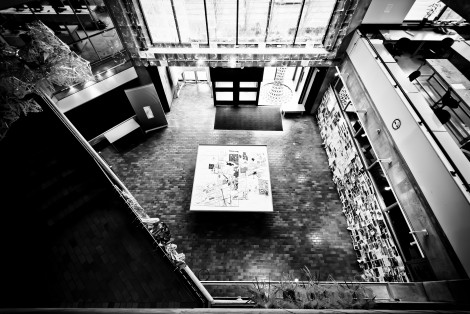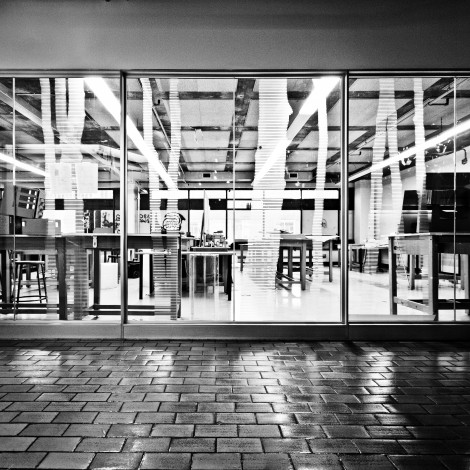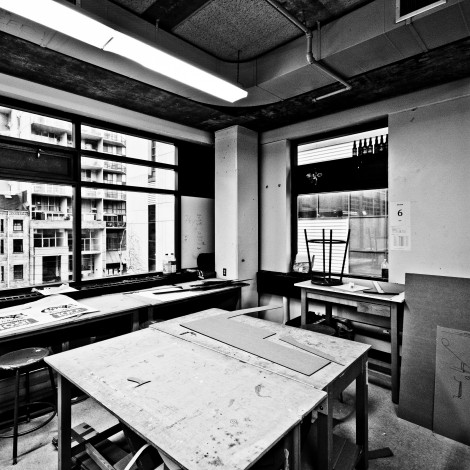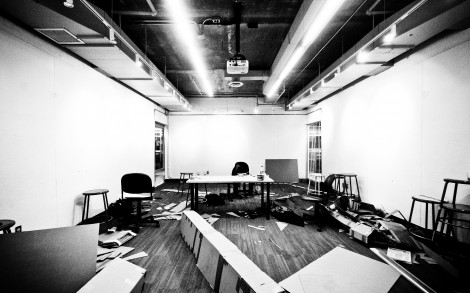It’s the summer of 2009, around midnight, and I’m breaking into Harvard. Well, not exactly — I’m sneaking into one of the vacant dorms, carrying drafting pencils, a T-square, some rulers, and a big roll of drafting paper. I’m not the only one. Though this wing of the Walter Gropius dormitories is supposed to be empty, every room I walk past is already occupied.
We’ve snuck past campus police, propping open doors and jamming locks with kneadable erasers. Everyone is nervous, sleep-deprived, and drinking Red Bull. Some haven’t slept for days. At this time of night, Gund Hall, home to Harvard’s Graduate School of Design, locks its doors — and our workbenches along with it. So we’re improvising: these dorm rooms have nice, wide desks, perfect for drafting. We work late into the night, and as the sun begins to rise, we pack up, sneaking back out one by one, cleaning up after ourselves as we go.
* * *
It’s a Monday night at Ryerson’s architecture department, and Ariel’s group is building a bridge. The assignment is simple enough: in groups of six, build a 12-foot long bridge out of nothing but cardboard and duct tape. If you can get three people to walk across the bridge one after another, your group gets a 90. If the entire group makes it across, you get perfect marks.
“Though our prof tells us it’s possible to get the full six people across, none of us really buy it,” Ariel explains. Just then, as a third group member steps onto the bridge, the structure collapses and everyone falls to the floor. “We’re getting closer,” he says. “We should have it by tomorrow.”
Rachel, also in Ariel’s group, chimes in. “I’m still going to wear a bathing suit under my clothes when it’s our turn.” At their prof’s insistence, the groups will be testing their completed bridges over a pool in the gymnasium.
Ariel and Rachel are both first-year students at Ryerson in the university’s competitive pre-professional architecture program, one of a handful in Canada. Once they finish their four-year degree, they’ll apply to architectural master’s programs. Though they’ve just started the program, the workload is intense.
“On the very first day, for the first assignment in September, I’d already pulled pretty much an all-nighter for the deadline,” explains Rachel. “It’s definitely hard on you. Sometimes you have two or three all-nighters in a row, and then coffee’s your best friend.”
Sleep deprivation is a constant for aspiring architects. Easier projects might take a single all-nighter while others cost weeks of lost sleep. “During the end of the semester, a lot of people started pulling all-nighters,” says Rachel. “The studio was full of people. There were people sleeping in studio, sleeping in the computer labs… [It got] kinda gross.”
At the end of last semester, Ariel lived in the computer lab for five days straight.
“Basically, everybody needed a computer, so if I left my spot and came back hoping to find a computer, there might not be one, and I wasn’t going to be able to work. I just never left, which also meant I got more work done, but less sleep.”
Not everyone can keep up with the lifestyle. “[Last semester], one of the professors took pictures of every single one of his students, and then as they started dropping out, he would cross off their picture,” says Rachel. “The pictures would be posted up in their section as well. So he started off with a group of 12 and ended up with a group of seven.”
* * *
I used to be an architecture student. For six weeks I studied at Harvard’s Graduate School of Design, enrolled in its “Career Discovery Program,” an intensive summer course meant to give people a taste of what pursuing a master’s in architecture feels like.
Students in the program come from all over North America, and though most are in university, some are older, often in their 40s or 50s. As the weeks progress, we look on as people silently pack up and leave the studio — casualties of the long, sleepless nights.
The hours are demanding. Gund Hall opens its doors at 8 am every day, and by 8:15 am, entire sections are already working on their projects. Many won’t leave the building until midnight, save to get coffee at Dunkin’ Donuts or some food at Darwin’s Sandwiches down the street.
Our instructors, all Harvard graduate students also enrolled in design programs, unhelpfully assure us that grad school is just like what we’re experiencing. “A lot of people don’t make it,” explains our drafting instructor. “You’ve got to have thick skin. If you’re questioning your resolve at all, you probably shouldn’t be here.”
Getting any sleep after pulling regular 16-hour days proves difficult. When I do manage to fall asleep, I dream of working in the studio, cutting foamboard or drafting up floorplans. When I wake up, I know I’ll need to go into the studio and do exactly what I’d imagined in my sleep all over again.
As we enter week four, I slice off a chunk of my thumb. I don’t have health insurance, so I clean and wrap the cut as tightly as I can, hoping not to bleed all over my model in the process.
In an effort to cheer me up, a studio instructor comes to my workbench and shows me his own scars, including a long line running across his right thumb. “See that? I once sliced off my thumb almost entirely,” he says. “It was hanging by skin alone!” He laughs. “Luckily, doctors were able to reattach it and it still works fine.”
I ask him whether I should go to a hospital. “That depends,” he says. “How’s your model coming along?” He’s only half-joking.
* * *
Architecture students like to exchange stories about their battles with X-ACTO knives, box cutters, and sandpaper. It’s a competition: everyone tells increasingly implausible tales of sleep deprivation and studio accidents.
“I kind of chopped off a whole section of my finger.” Rachel is wearing a hospital bracelet and she’s just gotten back to the studio. She laughs. “No stitches, because there’s no skin that’s salvageable, so they put in some foam or something to create a fake scar and bandaged it up.
“The blood was kinda gushin’ everywhere. One of my friends working on the bridge project went around with the skin that got chopped off, saying, ‘Rachel chopped off her finger! Everybody just take a look! Take a look!’”
Even though she’s only in first year, Rachel says high school doesn’t even begin to compare to architecture school. “High school was a challenge obviously, but once you get here, it’s like, ‘Okay, we’re going now.’ You can’t stop. You’ve got the ball rolling.
“It’s unfortunate because I don’t get to see my [residence] floormates as much as other people do, and sometimes, I feel left out of their social circles. But then when you come to studio, it’s more like your own family. It’s definitely a family.”
Ariel agrees. “It’s weird. I was originally in engineering, which is a 2,000-person program in first year because everyone’s taking the same course, and I thought, ‘Okay, I’m going to meet 2,000 people.’ But I ended up talking to maybe six people in my small circle of friends. But here, since there’s only 100 people and you’re basically stuck in a building for the whole night, you talk to everybody. There’s just a few people I haven’t actually talked to.”
Right now, having a social life is a luxury Ariel and Rachel can still afford. “The fourth-years tell us it only gets harder,” says Ariel.
It does. As I neared the end of my stint at Harvard, I’d already begun to question my resolve. It was the beginning of the end — and perhaps that was for the best. These days, it seems all my architect friends have become stressed out, alcoholic chain-smokers.
Rachel and Ariel are both unfazed by the three years of school still ahead. It’ll be more of the same: sleep loss, severed digits, and long nights in the computer lab. But at least for now, they’re happy.
It’s almost two in the morning as I prepare to leave Ryerson, and the computer lab is still half full. I take one final look at the studio: messy workbenches covered in styrofoam, box cutters, and cardboard. I briefly consider telling them my own architectural horror stories, but I decide against it.
It wouldn’t change a thing.

